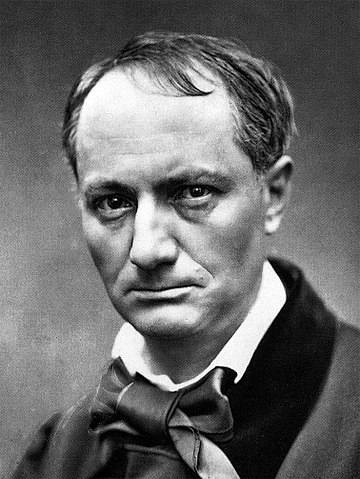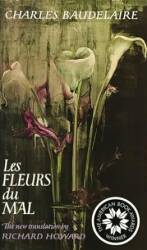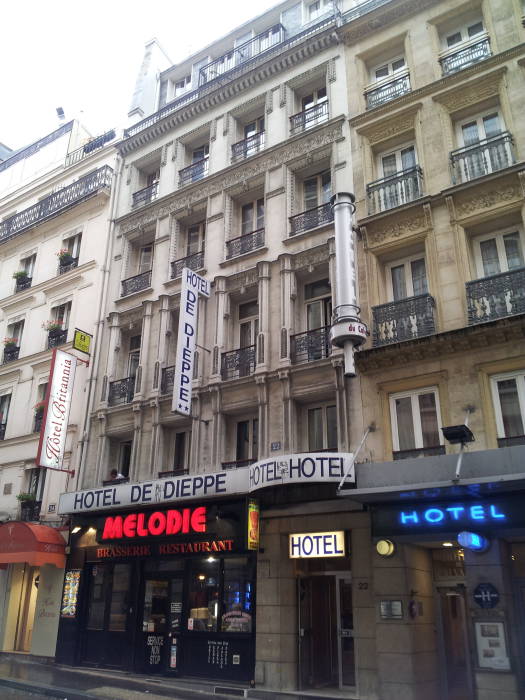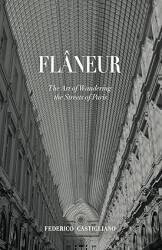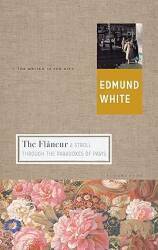
The Art of Flânerie
Gare Saint-Lazare, the Seine, and Place Saint-Michel
The flâneur
strolls as an acute observer of society.
The idea of flânerie
as strolling or idling dates to the 16th or 17th century.
Writers in the 19th century developed a rich set of
honorable interpretations of the flâneur
and flânerie.
Honoré de Balzac described
flânerie as "the gastronomy of the eye".
Anaïs Bazin stated that
"the only, the true sovereign of Paris is the
flâneur".
Charles Baudelaire is perhaps associated
more than any other writer with the explanation of the
flâneur.
He used the word to denote an artist whose mind is
independent, passionate, impartial,
"that which the language can only clumsily define."
Baudelaire also smoked opium, consumed laudanum (a tincture of opium dissolved in alcohol), and drank alcohol in excess, the combination of which led to his death. So, be careful out there.
Baudelaire lived for a while at the Hôtel de Dieppe near the Gare de Saint-Lazare train station. It's a relatively low-cost hotel by Paris standards where I once spent a few nights. Without laudanum.
Day trip to GivernyI have started by taking the Métro to Gare Saint-Lazare, where I investigated train schedules to Giverny, Claude Monet's home in Normandy. I will take a day trip there the following day. Today, though, will be more wandering through Paris.

The station now includes a very nice three-level shopping mall with 80 shops.

Gare Saint-Lazare, of course, has a piano to play if you're so inclined. Just like Gare du Nord. Because, what train station doesn't include a public piano?

There are brief schedules of departing and arriving Grandes Lignes or long-distance trains, and those of the Île-de-France, the region including Paris.


Gare Saint-Lazare is one of six large terminus railway stations in Paris. It is the second-busiest, after Gare du Nord, handling some 275,000 passengers each day riding to and from Normandy or closer areas to the northwest of Paris.

The station now has 27 platforms.

Schedules researched, I left the station, crossed the busy square, and walked down rue du Rome to Boulevard Haussmann.

That took me to the corner with the striking brasserie Triadou Haussmann. But rather than sit in it, I will sit across the street at the bar-brasserie-tabac Le Mistral and look at it. Le Mistral is the powerful cold wind that blows through Provence in winter and spring, driving people mad.

Sometimes the flâneur stops and lets the world pass by to be observed. Café, croissant, and a pleasant and interesting view.

Yes, traveling to work wearing a suit, carrying a briefcase, and riding a scooter is a very Parisian thing.

Before long I need more café. One doesn't shout "Garçon!", unless you're trying to pass for a French-speaking Nazi straight out of "Casablanca" or "Raiders of the Lost Ark". "Monsieur" or "Mademoiselle", or simply "S'il vous plaît..."

There goes another suit-wearing scooter rider, zipping along on an electrically powered one and carrying his papers in a small daypack.

The light blue-green bicycles are part of a city-operated rental system.


The green bicycle is another rental, while the light blue one is a personal ride.

Past les Grands Magasins
Georges-Eugène Haussmann served as the Prefect of Seine from 1853 to 1870. Emperor Napoléon III, the nephew of Napoléon Bonaparte, charged Haussmann with carrying out a massive urban renewal program. The street plan in places had changed little since the Middle Ages. Haussmann was to open things up, connect and unify different parts of the city, and make it more beautiful. The large boulevard running past the brasserie where I've been sitting is Boulevard Haussman. It runs past two of the grands magasins, the "Big Stores" of Paris.

Printemps is at the near corner at left in the picture above, Galleries Lafayette is further down on the same side of the boulevard.

in France
Printemps was founded in 1865. The first building was expanded in 1874, when they added elevators from the 1867 Universal Exposition. Elevators were quite the novelty in the 1870s. Then it became the first store to use electric lighting, in 1888.
The store marked items with set pricing, ending the system of haggling based on customer appearance which had been the norm in retail. The scale allowed them to offer high-quality goods at prices the growing middle class could afford, and they pioneered the concepts of discount sales and window displays.


I turned south along rue Tronchet, investigating side streets.

Across Place de la Concorde
I continued south along rue Tronchet, around La Madeleine, or formally L'église de la Sainte-Marie-Madeleine, and down rue Royale to Place de la Concorde.
At 7.6 hectares, this is the largest square in Paris. It was designed in 1755 as an octagon surrounded by a moat, decorated with statues and fountains. It was named Place Louis XV to honor the king. It was very royal, for a while.

By the time of the French Revolution in 1789, the statue of Louis XV had been pulled down and the square was renamed Place de la Révolution. The revolutionary government set up a guillotine, and King Louis XVI was executed here on 21 January 1793. Along with, on that and other days, his queen, Marie Antoinette; his sister, Princess Élisabeth; and his father's last Maîtresse-en-titre or official mistress, Madame du Barry. Also Georges Danton, an early leader of the Revolution. Be careful what you start.
Antoine Lavoisier, "the father of modern chemistry", was also guillotined here. He had recognized and named hydrogen and oxygen, disproved the phlogiston theory, predicted the existence of silicon, established that sulfur was an element, proved the conservation of mass, and helped design the metric system.
Flânerie past tollhouses of the Ferme généraleWith all that science he would seem to be the Revolutionary favorite. But, he was a member of several aristocratic councils, and worse yet, an administrator of the Ferme générale, one of the most-hated establishments. I had recently seen one of their tollhouses along the path of an old city wall during an earlier flânerie. The Revolutionaries charged him with tax fraud and the selling of adulterated tobacco, and guillotined him.
Below you see the Palais Bourbon, home of the French National Assembly, in the distance across the river. And, in the distance, the Eiffel Tower.

Luxor
The Luxor Obelisk stands in the center. It's 23 meters tall, over 3,000 years old, weighing over 250 metric tons. It once stood at the entrance to Luxor Temple in Egypt.
Muhammad Ali Pasha, the ruler of Ottoman Egypt, gave it to France in 1833 in exchange for a French mechanical clock. He had very high expectations for that clock.
After the obelisk had left for France on a specially built barge, the clock was discovered to be faulty, probably damaged during transport. The clock is still in Egypt, and still not working. Having been to Egypt, I find the clock to be a metaphor.

The Avenue des Champs-Élysées runs 1.9 kilometers from the Place de la Concorde to Place Charles de Gaulle and the Arc de Triomphe.
It has been the course of some significant parades — occupying German forces on 14 June 1940, and then the liberating Free French 2nd Armored Division and the US 28th Infantry Division on 26 August 1944.
Now it's the finish of the annual Tour de France.
Restez tranquille. Traffic will eventually clear enough for a casual stroll across.

Allons-y! There's the Arch de Triomphe at the far end, 1.9 kilometers away.

There are two large buildings on either corner of rue Royale along the north side of the Place. The one on the left is the Hôtel de Crillon, at right is the Naval Ministry.

The south fountain, closer to us in the view below, commemorates the maritime commerce and industry of France. The north fountain commemorates navigation and commerce on the rivers of France. And, I suppose, canals.

Now I'll turn 180° and start to cross Pont de la Concorde, the bridge across the Seine.
Along the Banks of the Seine
I'm at the north end of Pont de la Concorde, looking downstream toward the Eiffel Tower. I will go down the stairs to the quai, the path along the river bank. There, I will walk upstream, from the 8th into the 1st arrondissement.

The first Paris quai was was built in 1312 when King Philip IV the Fair commissioned today's Quai des Grand Augustins on the left bank. That was followed by the Quai de la Mégisserie and Quai des Célestins on the right bank. Before those, boats were simply pulled up onto the muddy banks.
King François I built more in 1530. Then in the early 17th century, King Henri IV demolished houses right along the river, creating space for stone wharfs on both banks.
Now some people make their homes on boats tied up along the quais.

UNESCO listed the Banks of the Seine as a World Heritage Site in 1991.

Amazon
ASIN: B00C061HZY
Amazon
ASIN: B0064UPU4G
Rollerblading remains hugely popular in France. To really do it right, rollerblade while listening to Daft Punk.


Napoléon III, nephew of Napoléon Bonaparte, ruled as the first President of France 1848–1852 and, as Emperor, the last French monarch 1852–1870. How did that work?
Montmartre and Pigalle FlânerieHe was elected president of the French Second Republic in 1848. In 1851, when he could not constitutionally be re-elected, he seized power and declared the Second French Empire with himself as Emperor. That ended in the Franco-Prussian War of 1870, Napoléon's capture, and the fall of the French Empire, along with the violent rule of the Commune in Paris. Signs of which I saw in a flâne through Montmartre and Pigalle.
Napoléon III inaugurated an iron bridge carrying vehicles between quai Anatole-France and quai des Tuileries in 1861. Barge collisions through the following century weakened it, so it was demolished and replaced in 1961 with a steel footbridge. That in turn was demolished in 1992.
The current steel footbridge was built in 1997–1999. And look, no piers! That will cut down on the barge collisions, although the ends of the arch come down to the waterline. So, it's not 100% barge-proof. Eiffel Constructions Métalliques built this bridge, they're still building metal structures.

The single-span pedestrian bridge was renamed after Léopold Sédar Senghor in 2006, on the centennial of his birth. Senghor, a poet, politician, and cultural theorist who served 1960–1980 as the first President of Senegal, was the first African elected as a member of the Académie Française, and is regarded by many as one of the most important African intellectuals of the 20th century. Theorists and theoreticians are seldom simple people:
Senghor was ideologically an African socialist, and he was the major theoretician of Négritude. Francophone intellectuals, writers, and politicians of the African diaspora developed Négritude during the 1930s. It's a framework of critique and literary theory aimed at raising and cultivating "Black consciousness" across Africa and its diaspora. They employed Marxist political philosophy in the Black radical tradition, drawing heavily on a surrealist literary style. I'm sure that Senghor could flâne like a madman.
The Musée d'Orsay is housed in the former Gare d'Orsay, a railway station built 1898–1900. By the start of World War II, its short platforms had become unsuitable for the longer trains used for mainline services, and it was used for suburban services.

At the end of World War II, however, Gare d'Orsay was the arrival station for many survivors returning to France.

It opened as a museum in 1986, holding mainly French art from 1848 to 1914, with the world's largest collection of Impressionist and post-Impressionist art.
It's a wonderful place to visit, but today I'll continue strolling.

I'm approaching the Pont Royal.

Pont Royal is the third oldest bridge in Paris. There had been a wooden toll bridge here since 1632, but it was burned, flooded, completely rebuilt, propped up, and finally completely carried away in a flood in 1684.
The bridge that survives today was built of stone in 1685–1689, financed by the king Louis XIV. So, the name "Pont Royal".



The Pont des Arts or Passerelle des Arts, the Bridge (or Pedestrian Bridge) of the Arts, was built in 1802–1804, during the reign of Napoléon Bonaparte. It was the first metal bridge in Paris. But that one had nine arches.

The French Ministry of Culture listed the 1802–1804 bridge as a national historic monument. However, in 1976 several physical deficiencies were noted. Aerial bombardments during World War I and World War II had caused damage. Then there had been multiple collisions by boats.
The bridge was closed to pedestrians in 1977 while further study could be done. But in 1979 a barge rammed it and collapsed a 60-meter section.
Today's bridge was built in 1981–1984, supposedly "identical in design" but with the number of arches reduced from nine to seven. It preserved the general look of the old bridge, but aligned it with the design of the Pont Neuf, the next bridge upstream.
And, perhaps more importantly, a smaller number of arches makes each one larger, hopefully reducing the frequency of barge strikes.

Now I'm crossing the Passerelle des Arts. I'm crossing from the Rive Droite or Right Bank to the Rive Gauche or Left Bank. Élégant on the right, bohème on the left, or so the stereotypes go.
Looking upstream in this picture, the Right Bank is on our left and the Left Bank is on our right.
That's Île de la Cité in the middle of the Seine. It was the original settlement of the Parisii, a small Gallic tribe who settled the island in 250–225 BCE. Clovis, ruling 481–511 CE, was the first Merovingian King of the Franks to unite all the Frankish tribes under one ruler. He built a palace at the western, downstream end, closest to us in this picture. The eastern, upstream, end has been dedicated to religion since Merovingian times. The residential and commercial remainder of the city fit between the two.

The Pont Neuf spans the river near the downstream end of Île de la Cité. In Parisian bridge irony, it was named Pont Neuf or "New Bridge" when it opened in 1604 to distinguish it from all the older bridges that were lined with houses along both sides. But now it's the oldest standing bridge across the Seine in Paris.

It used to just barely connect to the downstream tip of the island. Since 1604, the natural sandbar has grown downstream.

Amazon
ASIN: B01FGJQDOQ
Now I'll continue along the Rive Gauche on the Upper Quai, along a street, looking down on the mostly pedestrian-only Lower Quai.

This building along Quai de Conti near Pont Neuf was the base of an F.F.I. or Free French unit in August 1944, during the battle to liberate Paris.


State of Siege, or State of Seat? It's a chair store. Get it?

The Bouquinistes are the booksellers with their green stalls lining both banks.
There are 900 boxes, run by 240 bouquinistes, offering around 300,000 used books. They're open several days a week from 11:30 to sunset.

Peddlers called "libraires forains" operated along the Seine banks in the 16th century. In 1557, during the Wars of Religion, they were accused of being thieves selling forbidden Protestant pamphlets targeting the church and the government.
The number of booksellers increased when the Pont Neuf opened in 1604. They transported their books in wheelbarrows, and sold books from trays fastened to bridge parapets with thin leather straps.
The book trade in Paris had been monopolized by the clergy and the nobles. But then the French revolution emptied the contents of churches and châteaux. Many books that once belonged to the rich made their way to the Bouquinistes stalls.

In 1859, second-hand booksellers were granted the right to establish a business at a fixed point along the Seine banks by paying a concession fee. That fee gave them 10 meters of railing, along which they could sell their goods from sunrise to sunset.
In 1891 they were authorized to permanently attach their boxes to the railings, and in 1930 the dimensions of the green boxes were fixed for all sellers. In 1993 Jacques Chirac, Mayor of Paris, signed article 9 of the relevant by-law, further defining the dimensions. Each box can be 2 meters long and 0.75 meters wide, 0.6 meters tall on the Seine side and 0.35 meters on the shore side, with the lid closed. Open, the upper edge of the lid can be no more than 2.1 meters above ground. Only one out of every four boxes can sell sell tourist merchandise.
Each bookseller gets four such boxes, for an annual rent of €100. The waiting list for a permit is typically eight years or more.

Above you see that there is room for the flâneur on the sidewalk, and a special lane has been carved out of the street for bicycles, both electric and the still-popular foot-powered scooters, and rollerbladers.
Place Saint-Michel
Place Saint-Michel is an open square where the boundary between the 5th and 6th arrondissements reaches the Seine. That's Nôtre-Dame ahead of us. But I'm turning to the right, into Place Saint-Michel and the Latin Quarter.


There is a large fountain at the back of the square. It was originally designed to have a large central statue depicting Napoléon Bonaparte. But when it was being built in the late 1850s, opponents of his nephew Napoléon III, who had recently seized power as Emperor, objected.
The design was changed to depict Saint-Michel, the dragon-killer. The bases for the two dragon statues now bear tributes to those who lived through 50 months of German occupation and those who died fighting to liberate Paris in 1945.


Beyond the Métro station is one of several multi-level Gibert Jeaune book shops around the Place. The square was the site of the original Gibert Jeaune shop, opened in 1886. The proprieter had been a bouquiniste selling from a box on the railing along the quay.





An école maternelle is a pre-school or nursery school for children aged 3 to 5. In 2018 the école maternelle became compulsory for all children aged 3. But before that law, almost all children ages 3 through 5 were already attending. You don't have to force the French into education.

As required by law, the menu is posted. It's healthy, and the children learn social skills during meals. School will be closed for the Monday of Pentecost, on which the French do not "speak in tongues" or handle poisonous snakes.

There are memorials all through Paris to neighborhood members of the Résistance and related organizations.



Across the Seine into the Marais
Now I will wander back across the Seine into the Marais. This bridge, the Pont Nôtre-Dame, leading from the cathedral to the Hôtel-Ville seen below, is the "most ancient" in Paris in the sense that it's the oldest roughly-continuous location for a bridge. Many specific bridges have come and gone here.
The first bridge of Paris, the Grand-Pont, once crossed here. That version was destroyed during the Norman siege. It was replaced by the Pont des Plances de Milbray, the Milbray Plank Bridge. Then many more bridges before this one was built.

I cross into the 4th arrondissement, pass the front of City Hall, and turn its north-west corner to find another very recent (in Parisian time scales) historical marker.

On 20 August 1944, at dawn, the Resistance occupied
the City Hall.
During three days and four night, they resisted
the enemy's attacks.
On 23 August, the Parisian Committee of Liberation
moved in.
The evening of 24 August, the first soldiers of the
LeClerc Division arrived on site.
On 25 August 1944, Paris was liberated.
The bullet holes on the face of the City Hall
testify to the fighting.

A short distance down rue Rivoli I pass the Hôtel de Rivoli where I have stayed multiple times.

In the side streets north of rue Rivoli I come to le Pick-Clops.

Right Bank, but still a little bohemian.


Amazon
ASIN: 0804760314
This dog is quietly and patiently waiting for his human. But were he to bark, in French it would be "wouaff-wouaff", or "ouah-ouah", or "whou-whou", or "vaf-vaf", or, if small enough, "jappe-jappe". Most of those were demonstrated by Milou in the Tintin stories.

